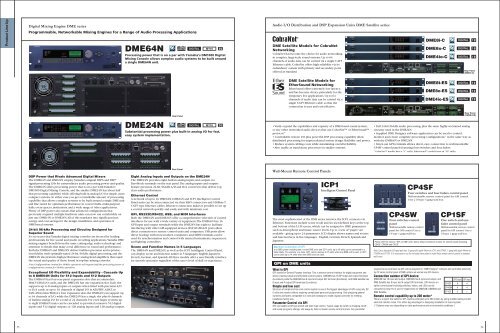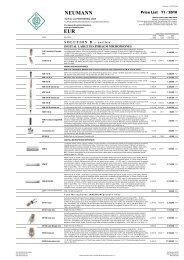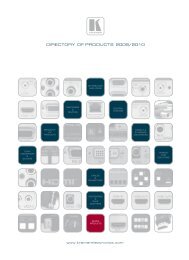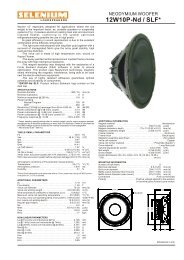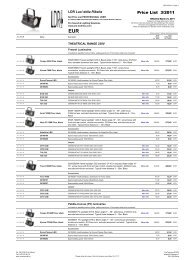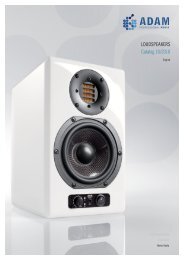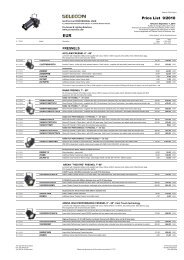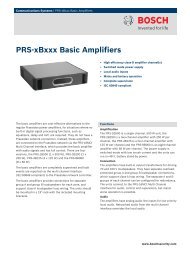Download - Yamaha Downloads
Download - Yamaha Downloads
Download - Yamaha Downloads
You also want an ePaper? Increase the reach of your titles
YUMPU automatically turns print PDFs into web optimized ePapers that Google loves.
Product Line Up<br />
Digital Mixing Engine DME series<br />
Programmable, Networkable Mixing Engines for a Range of Audio Processing Applications<br />
DSP Power that Rivals Advanced Digital Mixers<br />
The DME64N and DME24N employ <strong>Yamaha</strong>'s original DSP6 and DSP7<br />
signal-processing LSIs for extraordinary audio processing power and quality.<br />
The DME64N offers processing power that is on a par with <strong>Yamaha</strong>'s<br />
DM1000 Digital Mixing Console, and the smaller DME24N has about half<br />
that processing capability while offering built-in analog I/O for simple, more<br />
compact systems. In either case you get a remarkable amount of processing<br />
capability that allows complex systems to be built around a single DME unit<br />
and fine tuned for optimum performance in concert halls, multi-purpose<br />
halls, event spaces, institutions, and a wide range of other applications.<br />
Plenty of DSP power also means that advanced configurations that<br />
previously required multiple hardware units can now run comfortably on<br />
just one DME64N or DME24N. All of this translates into significant time,<br />
energy, and cost savings for the design, installation, and operation of<br />
DME-based systems.<br />
24-bit 96-kHz Processing and Circuitry Designed for<br />
Superior Sound<br />
It's no secret that <strong>Yamaha</strong> digital mixing consoles are favored by leading<br />
professionals for live sound and studio recording applications. <strong>Yamaha</strong> DME<br />
mixing engines benefit from the same cutting-edge audio technology and<br />
attention to details that make a real difference in sound and performance.<br />
Both the DME64N and DME24N deliver faultless precision and reproduction<br />
fidelity with optimally-tuned 24-bit, 96-kHz digital processing, and the<br />
DME24N also features high-performance analog head amplifiers that equal<br />
the sound and quality of those found in top-line mixing consoles.<br />
Note: Configurations created for 48-kHz operation will require half the processing power of<br />
configurations created for 96-kHz operation.<br />
Exceptional I/O Flexibility and Expandability - Cascade Up<br />
to 8 DME64N Units for 512 Inputs and 512 Outputs<br />
The DME64N has four rear-panel expansion slots that accommodate<br />
Mini-YGDAI I/O cards, and the DME24N has one expansion slot. Each slot<br />
supports up to 8 analog inputs or outputs when fitted with precision A/D<br />
or D/A cards, or up to 16 channels of digital I/O in AES/EBU, ADAT, or<br />
TASCAM format. With it's four expansion slots the DME64N can support up<br />
to 64 channels of I/O, while the DME24N has a single slot plus 8 channels<br />
of built-in analog I/O for a total of 24 channels. For even larger systems up<br />
to eight DME64N units can be cascaded to provided a massive 512 digital<br />
inputs and 512 digital outputs, or 128 analog inputs and 128 analog outputs.<br />
DME64N<br />
Processing power that is on a par with <strong>Yamaha</strong>’s DM1000 Digital<br />
Mixing Console allows complex audio systems to be built around<br />
a single DME64N unit.<br />
DME24N<br />
Rear Panel<br />
Substantial processing power plus built-in analog I/O for fast,<br />
easy system implementation.<br />
Rear Panel<br />
DIGITAL MY16<br />
DIGITAL MY16<br />
Eight Analog Inputs and Outputs on the DME24N<br />
The DME24N provides eight built-in analog inputs and outputs via<br />
Euroblock terminals on the rear panel. The analog inputs and outputs<br />
feature precision 24-bit, 96-kHz A/D and D/A converters that deliver top<br />
class audio performance.<br />
Ethernet Control<br />
A network of up to 16 DME64N, DME24N and ICP1 Intelligent Control<br />
Panel units can be interconnected via their RJ45 connectors and 100Base-T<br />
CAT5 type Ethernet cables. Ethernet connection makes it possible to set up<br />
a control network quickly and easily, and with minimum cost.<br />
GPI, RS232C/RS422, USB, and MIDI Interfaces<br />
Both the DME64N and DME24N offer a comprehensive selection of control<br />
interfaces for use with a wide variety of equipment. The DME64N has 16<br />
GPI input and output terminals while the DME24N has eight to facilitate<br />
interfacing with other GPI-equipped devices. RS232C/RS422 ports allow<br />
direct connection to remote control units and computers, USB ports allow<br />
direct hookup with most modern computers, and MIDI terminals can be<br />
used for synchronization and control with musical instruments, sequencers,<br />
and lighting controllers.<br />
Scene and Function Names in 5 Languages<br />
The DME64N and DME24N, as well as the ICP1 Intelligent Control Panel,<br />
can display scene and function names in 5 languages: English, Japanese,<br />
French, German, and Spanish. All three models offer a user-friendly interface<br />
for smooth operation regardless of the user's level of skill or experience.<br />
3U<br />
2U<br />
Audio I/O Distribution and DSP Expansion Units DME Satellite series<br />
DME Satellite Models for CobraNet<br />
Networking<br />
CobraNet has become the choice for audio networking<br />
in complex, large-scale sound systems. Up to 64<br />
channels of audio data can be carried via a single CAT5<br />
Ethernet cable. CobraNet offers high reliability via its<br />
redundancy system with primary and secondary ports<br />
offered as standard.<br />
DME Satellite Models for<br />
EtherSound Networking<br />
EtherSound offers extremely low latency,<br />
and has become choice paticularly for the<br />
temporary live applications. Up to 64<br />
channels of audio data can be carried via a<br />
single CAT5 Ethernet cable so that the<br />
connection is easy and cost-effective.<br />
Vastly expand the capabilities and capacity of a DME-based sound system,<br />
or any other networked audio devices that use CobraNet or EtherSound<br />
protocol.*<br />
Controllable remote I/O plus powerful DSP processing capability allow<br />
distributed processing for unprecedented system design flexibility and power.<br />
Reduce system cabling costs while maximizing overall reliability.<br />
Also usable as stand-alone processors in smaller systems.<br />
Wall-Mount Remote Control Panels<br />
GPI on DME units<br />
ICP1<br />
Intelligent Control Panel<br />
The most sophisticated of the DME series remotes, the ICP1 connects via<br />
Ethernet. Functions include scene recall and six user-defined keys at the top<br />
and bottom of the LCD screen, which can be assigned to DME parameters<br />
such as microphone and music source levels. Up to 4 sets of "pages" are<br />
available - giving up to 24 parameters. LCD display shows names and scenes<br />
and function keys in five languages - English, German, French, Spanish and<br />
Japanese.<br />
Maximum Connection of ICP1<br />
In a DME system including one or more DME units and ICP1 units, up to 16 units can be connected in a<br />
Zone totally. For example, in a Zone, ICP1 can be used up to 15 units when one DME unit is used, or ICP1<br />
can be used up to 14 units when two DME units are used.<br />
What is GPI<br />
GPI stands for General Purpose Interface. This is external control interface for digital equipment and<br />
allows creating simple and affordable control system. DME64N has 16 GPI input and output terminals<br />
(Euroblock) while the DME24N has 8 input and output GPI terminal (Euroblock). And DME Satellite has<br />
8 input and 4 output GPI terminals (Euroblock).<br />
Simple and low cost<br />
Structure of simple and low cost control system is one of the biggest advantages of GPI using only DC<br />
5 volts and resistor without requiring complicated parts and programming. Only preparing general<br />
switches and faders compatible to 5 volts are necessary to make original controller for meeting<br />
installation facility size.<br />
Parameter Control via GPI<br />
GPI can handle on/off type switch and fader type control. Typical usage by switch is changing on/off<br />
and scene (program) change, and usage by fader is master volume control and etc. Any parameter<br />
Full 24-bit 96-kHz audio processing, plus the same highly-acclaimed analog<br />
circuitry used in the DME24N.<br />
Supplied DME Designer software application can be used to control,<br />
monitor, and create complete processing“configurations” in the same way as<br />
with the DME64N or DME24N.<br />
8-in/4-out GPI terminals allows direct, easy connection to wall-mountable<br />
CP4SF control panels featuring four switches and four faders.<br />
* CobraNet models have a "-C" suffix. EtherSound models have an "-ES" suffix.<br />
CP4SF<br />
CP4SW<br />
Four switches control<br />
panel<br />
Wall-mountable remote control<br />
panel for GPI control. Uses a<br />
US-type 1 gang wall box.<br />
33 34<br />
DME8i-C<br />
DME8o-C<br />
DME4io-C<br />
DME8i-ES<br />
DME8o-ES<br />
DME4io-ES<br />
DIGITAL<br />
DIGITAL<br />
DIGITAL<br />
DIGITAL<br />
DIGITAL<br />
DIGITAL<br />
1U<br />
1U<br />
1U<br />
Rear Panel<br />
(DME8i-C)<br />
Four switches and four faders control panel<br />
Wall-mountable remote control panel for GPI control.<br />
Uses a US-type 3 gang wall box.<br />
1U<br />
1U<br />
1U<br />
Rear Panel<br />
(DME8i-ES)<br />
CP1SF<br />
One switch and one<br />
fader control panel<br />
Wall-mountable remote control<br />
panel for GPI control. Uses a<br />
US-type 1 gang wall box.<br />
Please refer the column “GPI on DME units” below about connection number for control panels including<br />
CS4SF, CP4SW and CP1SF.<br />
Note: Use a standard (US-type) wall box: 3-gang with depth 44mm for ICP1 and CP4SF, 1-gang with depth 44mm for<br />
CP4SW and CP1SF. It is necessary to use the included frame plate to install these remote control panels in standard<br />
wall boxes.<br />
required to be controlled via GPI can be assigned on “DME Designer” software and controlled externally<br />
by CP series control panel of DME options as well as any GPI devices.<br />
Connection number of GPI device<br />
DME64N has 16 input and output, DME24N has 8 input and output, and<br />
GPI Output GPI Input<br />
DME Satellite has 8 input and 4 output GPI terminals. GPI devices on<br />
option control panel including switches, faders, and LEDs can be<br />
connected in total 16, 8, and 12 respectively for DME64N, DME24N and<br />
CP4SF<br />
CP4SW<br />
8<br />
4<br />
4<br />
4<br />
DME Satellite.<br />
Remote control capability up to 200 meter*<br />
CP1SF 2 1<br />
There is a report that cable for GPI could be extended up to 200 meters by using shielded cable proofed<br />
electrical interfere noise. This offers big advantage for designing installation of sound system.<br />
(* Distance may vary depending on cable performance and environmental conditions.)


